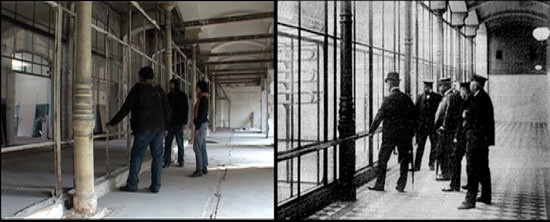1. Moving Titles
An animated sequence at the beginning of Raqs Media Collective’s two-screen film The Capital of Accumulation (2010) performs the title of the work’s reversal of the most important of Rosa Luxemburg’s economic studies, The Accumulation of Capital (1913).1 What can this mean as a reflection on the legacy, the corpse, and the spirit of Rosa Luxemburg?
In her 1913 book, Luxemburg boldly exposed the shortcomings of Karl Marx’s understanding of the process of the reproduction of capital. She suggested that the necessary growth in demand required by a constantly expanded production process could not be explained by an increase in the consumption of workers and capitalists. Instead, it had to be found elsewhere. Accumulation, Luxemburg showed, was a process that was not restricted to the origins of modernity in what Marx had described as “primitive accumulation”—consisting in the “divorcing of the producer from the means of production of wealth,” where “conquest, enslavement, robbery, murder, briefly force, play the great part.”2 Instead, capital’s history is tantamount to constant “modernization”—vampirization and ultimately the annihilation of capitalism’s others.3
We owe to Luxemburg the insight that capitalism is the first and only economy “which tends to engulf the entire globe and to stamp out all other economies.” For, as Luxemburg argued, capitalism was also “the first mode of economy unable to exist by itself.”4 This means that, like any other parasitic life-form, capitalism stands in a relation of dependence to whatever it encroaches upon.
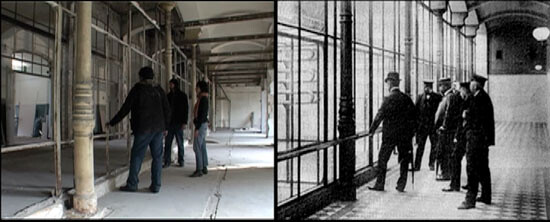

How can the action of capital accumulating become the predicate, the substance, a key feature of another kind of capital, one that is not the subject of a perpetual and desperate spiral of accumulation, but one that is, in fact, the profit and the sedimentary currency of accumulation itself? Raqs Media Collective’s film—which grew out of a long and devoted familiarity with Luxemburg’s thought that began with the abridged version of The Accumulation of Capital published in Delhi by Kamunist Kranti in 1990 5—provides a preliminary answer at the very beginning of the film, alluding to the existence of another kind of ghostly, ethereal, and residual accumulation:
When I saw you walk the city streets, I heard you listen to the voice of falling leaves on the forest floor. This too was an accumulation: this heap of leaves, this gathering of open veins; a compost of dreams exhausted and harvesting the light of oblique sun.6
The Capital of Accumulation is thus an attempt to tune our ears to the voice of the falling leaves of history. The intention is to move beyond a contemplation of today’s capitalist economy, even as it finds itself in the process of finally exhausting (as predicted by much theory, especially that of Luxemburg) the adjacent “non-capitalist” and “pre-capitalist” territories from which it extracted the premise of its own expansion.
The long-standing Hegelian tradition of irony grants the title’s pun and the chiasmic device of inverting sentences, categories, and figures a dialectical value: it is, in the case of Marx, nothing less than the grammar of critique, the surgical tool by which error is corrected through semantically turning it on its head. But inversion is also a means to express development—a diagram of the working mechanism of thinking that develops an argument by leveraging the contradictions of thought itself. Inversion is that tentative instrument which, in the wrong hands, became the “logic of the dialectic.” To Raqs it is a glimpse into the future of the past, from the vantage point of the present. This “present” is not a hypothetical or theoretical construct, but a thing of flesh and bone.
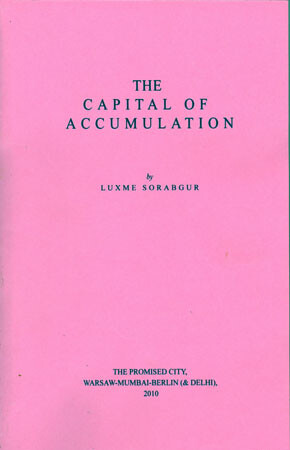

2. The Corpse of Theory (or a Theory of the Corpse)
The Capital of Accumulation is, thus, a discourse on the legacy of Luxemburg emerging from the voices of the beings, the matter, the territory and the social experiences and communities that are engulfed and subsumed within Capitalism. The voices convoked in the film appear as arriving at a perpetual “Victoria Terminus”—the former name of Bombay/Mumbai’s biggest railway station, where migrants to the city would disembark—as if having to endure the task of bearing witness to what is left behind:
They came bearing with them the dust of hinterlands, the ashes of war, and the aftertaste of famines. They were the forest, the mountain, the desert, the scar of an open cast mine. They came every day, day after day.
The forest withers, the mountain falls on its knees, the desert turns into a mirage, the mine makes money and then some more, then the seam runs dry. A factory closes. A mall refuses to open. Variable capital becomes constant and then metastasizes. Living labor dies and then waits its postmortem turn on a gurney in a forensic laboratory.7
One of the main narratives of The Capital of Accumulation is a drift through an uncertain necropolis: the search for Rosa Luxemburg’s body. Yet the pursuit for the missing body of Luxemburg that Raqs evokes does not take place in the Friedrichsfelde Cemetery—where what appeared to be her remains were first buried next to Karl Liebknecht in 1919, after both Spartacist leaders were murdered by the proto-Nazi Freikorps following the failed Berlin Commune of December 1918. That grave lay empty after having been desecrated by the Nazis in 1935.
The identity of the corpse formerly occupying that grave became uncertain (in retrospect) when in 2007 Dr. Michael Tsokos, head of the Institute of Legal Medicine in Berlin, disclosed the possibility that an unidentified mummified torso lying for decades in the vitrines of the Charité Hospital in East Berlin could in fact be the remains of Rosa Luxemburg.8 Raqs does not just explore the failed attempts to identify this corpse, but more appropriately document their own search: looking at the ruins of the empty vitrines of the Charité Hospital, interviewing Dr. Tsokos and filming his laboratory, exploring the photographs of Luxemburg and the documents that were unable to yield DNA traces adequate to the task of verifying the identity of the corpse.
The (dis)appearance of Rosa Luxemburg’s body in Raqs’s work occupies the space of a theoretical fable: that of an unsettled and unclaimed genealogy, uncertain precisely because it can’t be built on the firm marking of a grave.
This meditation on the evanescent destiny of Luxemburg’s corpse is not idle speculation, for it might well be that few cadavers are as decisive in the history of the Left. It is not only that her execution by paramilitary forces—backed by the Social Democrat government whose war minister, Gustave Noske, had spearheaded the repression of the revolution in Berlin in December 1918—marked the symbolic start of proto-fascist violence in Europe.9 It is also the marker of the irrevocable schism. As Hannah Arendt wrote in her beautiful assessment of the political significance of Luxemburg’s work, quoting in turn Luxemburg’s biographer J. P. Nettl:
With the murder of Rosa Luxemburg and Liebknecht, the split of the European Left into Socialist and Communist parties became irrevocable; “the abyss which the Communists pictured in theory had become … the abyss of the grave” … and it became the point of no return for the German Left … those who had drifted to the Communist Party experienced a bitter disappointment with the swift moral decline and political disintegration of the Communist Party, and yet they felt that to return to the ranks of the Socialists would mean to condone the murder of Rosa.10
However, rather than delving into the “truth” of the corpse or making a fetish of it in the way in which “actually existing socialists” mummified their quasi-monarchic leaders, Raqs turns their quest for Luxemburg’s ghost into a transcontinental investigation of the encroachment of capitalism upon the organic resources of our bodies and upon the time of the living, while maintaining a relation to the history of labor and the labor movement through a number of poetic excavations of the social fabric of three contemporary cities: Berlin, Mumbai, and Warsaw. Their procedure has a certain wandering, peripatetic quality, echoing perhaps the fact that rather than the arrested stillness of the embalmed cadavers in “red mausoleums,” true revolutionary heroes and martyrs are those who are marked in death, as much as in life, by the restlessness of their bodies.11 Raqs’s journeys yield analytical allegories and travelogues, written in an algebra of the relations between exploitation and resistance, desire and alienation—an algebra of the micrologics of daily life found when sifting through the evidence that gathers as history stands trial. “Who’s ever measured (re)voltage?”
Looking at the “crater” of ash where clay tea mugs are baked in Mumbai, they throw themselves into a meditation on the function of stimulants in the process of extracting surplus value.
The tea, a sweet, hot cutting of chai, injects a shot of caffeine and calories into a multitude of bodies. A spark of energy bolts the body out of the fog of fatigue. The spark sets a flame of concentrated labor. Work continues till the next tea break. Calories burn like forest fires on the second shift of the working day. And the working day is full of working bodies … Every tea break is a battle; a campaign in the long history of class antagonism. How often, where, when shall we drink tea? Every second and every calorie is fought for in the shop floor. Each fraction of time saved is put away in trying to understand the ghost in the machine.12
Filming the dust that accumulates in a former light bulb factory named after Rosa Luxemburg in Warsaw, they find the place suitable for new readings on the accumulation of capital. They echo a voice that identifies the abandoned factory as the space where the “underground haunts (the) memory of production.” The informal exchanges born in the street market in a former stadium in Warsaw appear as evidence of the activity of “the last international.” There, they listen to all kinds of immigrants who appear as the constituents of a “babel reborn in Babylon.” Raqs stands with them under “a canopy of solidarities” and within “a network of needs” that introduce different rhythms on top of the ruins of a failed dream. All of these are the sights and sounds of the sublime, seemingly impossible reverberations produced by the current extension of capital, inhabited by ghosts and paranormal phenomena, embodying the possibility of post-industrial reincarnation. It is all of this that prompts Raqs to ask: “Can the relations that we desire be written in terms of addition and subtraction? Can a factory die in one place and be born in another?”
These recursive moves, slices of life and afterlife, culminate in an examination of the relationship between life-forms and the logic of accumulation. We hear the voices of the animals caged in the Berlin Zoo—whose predecessors must have witnessed the body of Rosa Luxemburg floating in the nearby canal—talk about liberty, the forest, and the demands of growth as they testify to her execution. We witness a meditation on how the “two thousand fragments of possibility”—a flock of flamingoes that occupies the mud flats at the edges of Mumbai—remains oblivious to the plans to transform the space into a special economic zone in six months time.
The life-forms appear as bearers of an un-thought resistance to the plans of expansion. Living in a time other than that of the constant acceleration of capital, they appear to Raqs as if they were echoing the last words written by Rosa Luxemburg, which reflected on the persistence of the revolution despite the temporary prevalence of order: “I was, I am, I will be.”13
These sequences point towards a new sensibility, an epistemology that confronts the brutal poetics of globalization by counterposing affect to the idea of gross product, such that even the abundance of capitalism can only be seen as but a pale shadow of the exuberance of life and desire.
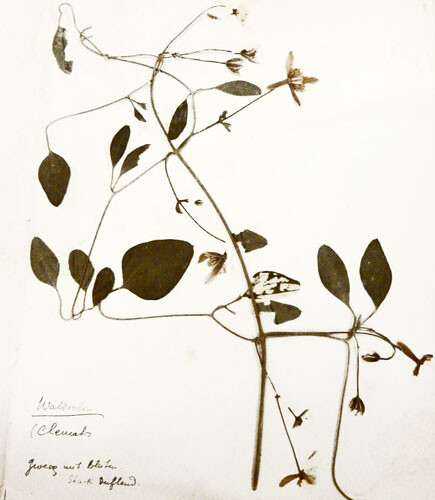

3. In Defense of the Infinite
Beyond the symbolic value Luxemburg carries as an icon of an alternative revolutionary-democratic Left, she remains an intriguing example of the possibilities of a creative non-dogmatic thinking. Her practice of theory and her theory of practice are based on a heightened sensitivity to long-term and distant processes; on the identifications of resonances between the realms of nature and history; on the need to constantly relate specific, concrete observations and general, social theories; and on the cross-fertilization between the tasks of reflecting on political experiences and recognizing the worth of organic forms of life.
This is the sensibility that Hannah Arendt tried to rescue when she argued that Lenin’s criticism of Luxemburg’s “theoretical errors” was in fact a reaction to her robust intellectual independence. Arendt argues that Luxemburg’s thought, as embodied in books like The Accumulation of Capital, appeared as “essentially non-Marxist” to Lenin because of the way it refused to stay confined within the internal presumptions of Hegelian dialectics: “The trouble was that what was an error in abstract Marxian theory was an eminent faithful description of things as they really were.”14
In the summer of 1916, British astronomer Oliver Rowland Walkey published several articles in scientific magazines like Nature and Scientific American claiming that the Sidereal Center of the universe could be roughly located at the position of the Canopus Star.15 When reading about Walkey’s discoveries while imprisoned in Poznań for trying to mobilize the proletariat against the imperialist world war, Rosa Luxemburg became enraged at what she felt was a petit-bourgeois attempt to reduce the universe to a measurable ball: “It seems that even without any fault of mine the world of stars has got into disorder … nothing more nor less than the infinity of the universe goes by the boards.” Her claustrophobic horror at the absurdity of a “globe-like infinity” was not merely astronomical. As she suggested in a letter to Louise Kautsky, the idea of emancipation was, for her, conditioned by the supposition of the limitless: “For my spiritual comfort, I must have something more than human stupidity to think of as infinite! As you can see, I literally have the cares of Herr von Kant.”16
Luxemburg’s ironic allusion to Kant’s Critique of Practical Reason, which famously relates “the consciousness of my existence” to the awe at “the starry heavens above and the moral law within,” goes well beyond the space of a private joke between two women who were friends and comrades.17 It encapsulates the centrality Luxemburg attributed to a fluid form of reason and knowledge based on experience and sense perception, conditioned by a pursuit of cultural refinement, in her project of the international revolution.
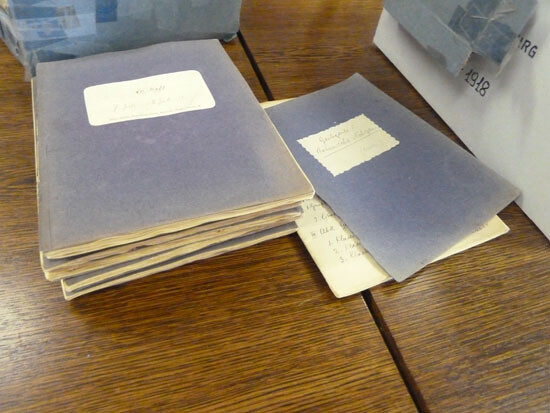

4. The Oracle in a Herbarium
If capitalist modernity has both repressed and preserved in the notion of “art” the connection between a concrete modality of practice and an overreaching form of dissident thinking, which depends on a certain restricted field of production, Luxemburg’s attempt to think through the connections of the organic particular and the abstractions of capitalism found an instrument and referent in her practice as amateur botanist. From May 1913 to October 1918, all through the years she spent in and out of German prisons, Luxemburg kept a herbarium consisting of eighteen notebooks, which are currently kept in the Akt Nowych (Recent Records) Archive in Warsaw.18
I had an opportunity to handle these notebooks myself in in 2011.19 Browsing through those slim and slender blue notebooks full of glued samples of flowers and leaves that fall into fragments in one’s hand, one cannot but feel awe at the complex subjectivity that gave rise to revolutionary thought well before “the suppression of percipient thinking” (as Victor Serge called it) imposed the stereotype of the communist militant and the intellectual as the cog in the wheel of a historical legality embodied by the party avant-garde.20 When Luxemburg confides her need to give “a good look at the trees and shrubs in the park … to see that they were all old friends” rather than deal with people with whom contact “grows continually more unsatisfying,”21 she appears close in spirit to her critique of the incapacity of “the rigid, mechanical-bureaucratic conception [that] cannot conceive of the struggle save as the product of organization at a stage of its strength.” In fact, as Luxemburg puts it, “the living, dialectical explanation makes the organization arise as a product of the struggle.”22
The act of browsing through the herbarium somehow makes it abundantly clear that the ethos that the revolutionary had tried to convince her comrades to respond and remain alive to was the “growing heat” of the “delicate, vibrant, sensitive political atmosphere in which the waves of popular feeling, the pulse of popular life, work.”23 If she could raise a warning about the dictatorial course that the Bolsheviks took after seizing power (“the remedy which Trotsky and Lenin have found, the elimination of democracy as such, is worse than the disease it is supposed to cure, for it stops the very living source from which alone can come correction for all the innate shortcomings of social institutions”24), it was because she had managed to escape the shortcomings of a restricted economy of reason, one based on the idea that thought, theory, and will dictate action. Instead, she developed the idea that action arose from a complex mixture of understanding, sensation, and practice within the perplexing maelstrom of history. It was precisely because she had a catastrophic view of society that was tantamount to some sort of “natural history” of capitalism that she could also remain faithful to an ethical stance that was not compromised by the monstrous nature of her time.
The notion of “catastrophe” is not necessarily the idée fixe of those who yield to a determinist view of society. Their fidelity to determinism leads them to relinquish their ability to create power. The notion of “catastrophe” is also the signature that distinguishes those who conceive the indeterminacy of history as a condition of action and thought. This contingency then becomes the ground on which they undertake their “thinking-while-acting-out” of an open concept of time.
There is a certain impassioned amorality in Luxemburg’s view of modernity that helped preserve her own faith in the possibility self-organized collective action. This is based, precisely, in an awareness of the enormous complexity of the situation that confronts the revolutionary, an awareness that could not be domesticated into simply mirroring the moralistic ways of thinking of the bourgeoisie:
It is absurd to apply moral standards to the great elemental forces that manifest themselves in a hurricane, a flood , or an eclipse of the sun … Manifestly, objectively considered, these are the only possible lines along which history can move, and we must follow the movement without losing sight of the main trend. I have the feeling that all this moral filth through which we are wading … may all of a sudden … be transformed into its very opposite, as if by the stroke of a magician’s wand it may become something stupendously great and heroic. 25
This is the breadth of a view that, on the one hand, rejected the notion of historical determinism, and on the other, berated the lack of sensitivity entailed in the avant-gardism of political cadres.
The overall effects of different social structures on societies, individuals, and organic beings overrides, to a certain extent, purely political notion of “history as class struggle.” It was the same awareness that noticed the connection between the disappearance of song birds in Germany and the extension of agriculture and the colonialist extermination of Indians in North America. This was the economic theorist who corrected Marx’s Eurocentric view of industrial modernity by underscoring the fact that capitalist accumulation depends on the appropriation of the resources originating in nature and “from all corners of the earth, seizing them, if necessary by force, from all levels of civilization and from all forms of society.”26 This redefinition of the global economic process as “a relationship between capital and a non-capitalist environment” is the core of Rosa Luxemburg’s argument in The Accumulation of Capital.27
None of this would probably have made sense to Luxemburg without her recognition of the commitment within her that she playfully mocked as the “morbid intensity” of her “interest in organic nature.”28 It was the intensity of this interest that allowed her to think through the continuous disaster of capitalist history without recourse to any illusion of permanence or control. The words she wrote from the prison in Breslau on May 12, 1918 appear, today, as pertinent as ever:
What we are now witnessing is the submergence of the old world, day by day another fragment sinks beneath the waters, day by day there is a fresh catastrophe. The strangest thing is that most people see nothing of it, but continue to imagine that the ground is firm beneath their feet.29
Thoughts like these call out to be taken forward. They would need to be the points of departure of the (as yet unwritten) treatise that Raqs Media Collective has baptized as The Capital of Accumulation.
It is this spirit that retains the capacity to animate the kind of enquiry needed today in order to overcome the gloom of post-Marxist theory: an openness to the miscegenation of illuminations and facts, rebellion and receptivity, stories and theories. This is where, in fact, the true legacy of Rosa Luxemburg lies waiting for its inheritors. And so the interrogation of the accumulation of defeat and rebellion can begin afresh. Such an undertaking, according to Raqs, may prove to be much more fruitful today than the exhaustion and surrender that results from the perpetual and sterile analysis of capitalism itself:
— We have looked too long to find the face of Capital. We thought we could turn a mirror to Medusa’s head, but the mirror became our mask and we found Medusa’s image infecting our vision. Like birds with mirrors, we have fought with our own reflection. We fought images with images, and we are like exhausted birds who have succumbed to the hardness of the surface that they were railing against.
— So how do you stop being imprisoned by this mirror? How do we stop analysis from turning into fatalism and then fatally wounding us?
— You might allow yourself to be surprised by what the world might become.30
Surely, such a horizon of possibilities does not spring from mourning the corpse, neither does it emerge from the emulation of specific political historical choices of the past, or fidelity to specific dead words and tactics. Rather, it arises in the attempt to hold on to a relationship with an ever-surprising world where the revolution, rather than being a slogan or a theoretical object, merely is.
Because, against the mechanical logic of history, “victories will spring from … ‘defeat.’”31
Because, in the midst of barbarism, every layer of time and thinking needs to co(i)nspire, reverberate, and accumulate, as if they were forming the heap of dead leaves that constitutes the fertile biomass of the forest floor. It is in the depths of that immense herbarium of undergrowth that The Capital of Accumulation finds its moisture, its sustenance, and its seeds.
Download Raqs Media Collective’s The Capital of Accumulation at →. This viewing copy places the two screens of the video in one, in order to be played on a laptop and listened to on headphones.
Karl Marx, Capital: A Critique of Political Economy, Vol. I (1867) (Moscow: Progress Publishers), Ch. 26. For online edition, see →.
“Capitalism needs non-capitalist social strata as a market for its surplus value, as a source of supply for its means of production and as a reservoir of labor power for its wage system … Capitalism must therefore always and everywhere fight a battle of annihilation against every historical form of natural economy that it encounters.” Rosa Luxemburg, The Accumulation of Capital, trans. Agnes Schwarzchild (New York: Routledge, 2003), 348–349.
Ibid., 447.
Rosa Luxemburg, The Accumulation of Capital. (An Abridged Version) (Delhi: Kamunist Kranti, 1990). Kamunist Kranti (KK) was a left-wing worker-student group located in Faridabad (an industrial suburb of Delhi). KK included Jeebesh Bagchi amongst its members, who two years later, in 1992, together with Monica Narula and Shuddhabrata Sengupta, formed the Raqs Media Collective.
“Prologue” in The Capital of Accumulation.
Ibid.
For a concise narrative of the case, see Emily Witt, “The Mystery of Rosa Luxemburg’s Corpse,” March 1, 2011, The Observer, →.
As Hannah Arendt put it: “Since this early crime had been aided and abetted by the government, it initiated the death dance in postwar Germany … Thus Rosa Luxemburg’s death became the watershed between two eras in Germany.” Hannah Arendt, Men in Dark Times (New York: Harvest Books, 1993), 36.
Ibid.
I borrow the idea from journalist Emily Witt: “The most romanticized Marxists, though, are the ones that got away, the locations of their bodies not verified for decades: Che Guevara, who was shot in the jungles of Bolivia; Patrice Lumumba, who was shot in the jungles of the Congo; Salvador Allende, who was shot (or shot himself) in the Chilean presidential palace and dumped in an unmarked grave in Valparaíso for the length of Augusto Pinochet’s dictatorship. And finally there is one whose corpse remains officially missing: Rosa Luxemburg, who was also shot, in a car in Berlin, and dumped in a canal.” Witt, “The Mystery of Rosa Luxemburg’s Corpse”
From “Antagonism” in The Capital of Accumulation.
Rosa Luxemburg, “Order Prevails in Berlin,” January 1919. See → .
Arendt, Men in Dark Times, 40.
O. R. Walkey, “The Sidereal Center: Considerations Tending to Indicate that Canopus Occupies this Position,” Scientific American Supplement, 2111 (June, 17 1916): 386.
Rosa Luxemburg: Reflections and Writings, ed. Paul Le Blanc (Amherst, NY: Humanity Books, 1999), 216.
Immanuel Kant, Critique of Practical Reason and Other Works on the Theory of Ethics, trans. Thomas Kingsmill Abbott, (New York: Barnes and Noble, 2004), 260.
There is a facsimile of them: Rosa Luxemburg/Ròza Luksemburg, Herbarium/Zielnik (Warsaw: Fundacja im. Rozy Luksemburg, 2009). The book reproduces the whole of the document but adds a mocked-up frame to the pages that alters the simplicity of the notebook to suggest the idea of a collection of independent images.
Instigated by the implications of the work of the Raqs Media Collective on Rosa Luxemburg, I unsuccessfully tried to borrow the herbarium for Manifesta 9 in Genk in 2012. Reasons of conservation made this project impossible. This text is, however, inspired by the smell of those fragile plants I had the privilege of browsing through in Warsaw.
Victor Serge, Memoirs of a Revolutionary, trans. Peter Sedgwick (Iowa City: University of Iowa Press, 2002), 375.
Rosa Luxemburg, Letters from Prison, trans. Eden and Cedar Paul (Berlin: Publishing House of the Young International, 1923), 11.
Rosa Luxemburg, The Essential Rosa Luxemburg: Reform or Revolution and The Mass Strike, ed. Helen Scott (Chicago: Haymarket Books, 2008), 157.
Ibid.
Rosa Luxemburg, The Russian Revolution, 1918. See → .
Luxemburg, Letters from Prison, 48–49.
Luxemburg, The Accumulation of Capital, 338.
Ibid., 398.
Luxemburg, Letters from Prison, 67.
Luxemburg, Letters from Prison, 68–69.
From “The Protagonist” in The Capital of Accumulation.
Rosa Luxemburg, “Order Prevails in Berlin.”
